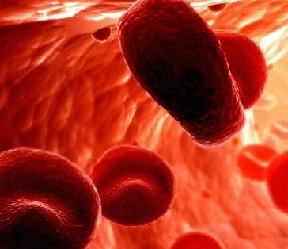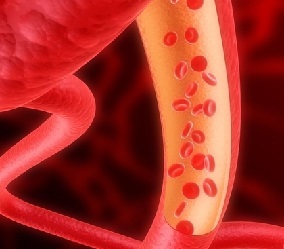 Anemia is a decrease in the blood count of red blood cells - erythrocytes below 4.0x109 / L, or a decrease in hemoglobin levels below 130 g / L in men and below 120 g / L in women. Anemia in pregnancy is characterized by a decrease in hemoglobin below 110 g / l.
Anemia is a decrease in the blood count of red blood cells - erythrocytes below 4.0x109 / L, or a decrease in hemoglobin levels below 130 g / L in men and below 120 g / L in women. Anemia in pregnancy is characterized by a decrease in hemoglobin below 110 g / l.
This is not an independent disease, anemia occurs as a syndrome with a variety of diseases and leads to a disruption in the supply of oxygen all organs and tissues of the body, which, in turn, provokes the development of many other diseases and pathological conditions.
Degrees of gravity
Depending on the concentration of hemoglobin, it is customary to distinguish three degrees of severity of anemia:
- Anemia 1 degree is recorded when the hemoglobin level decreases more than 20% of the normal value;
- Anemia of the 2nd degree is characterized by a decrease in the hemoglobin content by about 20-40% of the normal level;
- anemia of the 3rd degree is the most severe form of the disease, when hemoglobin decreases more than 40% of the normal index.
It is unambiguous to show that the patient has 1 degree or else a more serious stage can only be a blood test.
Causes
What is it: anemia, that is anemia, is nothing but a lack of hemoglobin in the blood. Namely hemoglobin transfers oxygen on all tissues of an organism. That is, anemia is caused precisely by the lack of oxygen in the cells of all organs and systems.
- Nature of food. With insufficient intake of iron-containing foods, iron deficiency anemia may develop, this is more characteristic of groups of the population where a high level of alimentary anemia already exists;
- Disturbance in the work of the gastrointestinal tract (in case of violations of the absorption process). Since the absorption of iron occurs in the stomach and upper part of the small intestine, with the violation of the absorption process, the mucosa of the digestive tract, this disease develops.
- Chronic hemorrhage (gastrointestinal bleeding, nosebleeds, hemoptysis, hematuria, uterine bleeding). Belongs to one of the most important causes of iron deficiency conditions.
Thus, the cause of anemia can be considered a deficiency in the body of iron, which leads to a lack of hemoglobin and, consequently, insufficient supply of the body with blood.
Iron-deficiency anemia
The most common form of anemia. It is based on a violation of the synthesis of hemoglobin (an oxygen carrier) due to iron deficiency. It is manifested by dizziness, noise in the ears, flickering flies before the eyes, shortness of breath, palpitations. Dryness of the skin, pallor, dry mouths, cracks appear in the corners of the mouth. Typical manifestations are fragility and lameness of nails, they are peppery striated.
Aplastic anemia
This is the most frequently acquired acute, subacute or chronic disease of the blood system, which is based on a violation hematopoietic function of the bone marrow, namely, a sharp decrease in its ability to produce blood cells.
Sometimes aplastic anemia begins acutely and rapidly develops. But more often the disease appears gradually and does not show bright symptoms for quite a long time. Symptoms of aplastic anemia include all the symptoms that are typical for a deficiency of red blood cells, platelets and leukocytes in the blood.
B12-deficiency anemia
It occurs when there is a deficiency in the body of vitamin B12, which is necessary for the growth and maturation of red blood cells in the bone marrow, as well as for the proper functioning of the nervous system. For this reason, one of the distinctive symptoms of B12-deficiency anemia are tingling and numbness in the fingers, a shaky gait.
In the blood, red blood cells are found of a particularly enlarged form. Lack of vitamin B12 can be observed in the elderly, with diseases of the digestive tract, in the presence of parasites - tapeworms.
Hemolytic anemia
Hemolysis occurs under the influence of antibodies. It can be the mother's antibodies directed against the red blood cells of the child with the incompatibility of the child and the mother according to the Rhesus antigen and much less often in the antigens of the ABO system. Antibodies against native red blood cells can be active at normal temperature or only with cooling.
They can appear for no apparent reason or in connection with the fixation on the erythrocytes of foreign to the organism incomplete antigen-haptens.
Symptoms
We list the main signs of anemia, which can disturb a person.
- pallor of the skin;
- increased heart rate and breathing;
- fast fatiguability;
- headache;
- dizziness;
- noise in ears;
- stains in the eyes;
- muscle weakness;
- difficulty concentrating;
- irritability;
- lethargy;
- a slight increase in temperature.
Symptoms of anemia
Among the symptoms of anemia, the leading ones are manifestations directly related to hypoxia. The degree of clinical manifestations depends on the severity of the decrease in the number of hemoglobin.
- At a mild degree (hemoglobin level 115-90 g / l), general weakness, increased fatigue, decreased concentration of attention can be observed.
- At an average (90-70 g / l) patients complain of shortness of breath, rapid heartbeat, frequent headache, sleep disturbance, tinnitus, decreased appetite, lack of sexual desire. Patients differ in pale skin.
- In the case of a severe degree (hemoglobin less than 70 g / l), symptoms of heart failure develop.
When anemia symptoms in many cases do not manifest themselves. It is possible to detect the disease only in laboratory studies of blood.
Diagnosis of the disease
In order to understand how to treat anemia it is important to determine its type and cause of development. The main method of diagnosing this disease is to examine the patient's blood.
The normal values of hemoglobin in the blood are:
- for men 130-160 grams per liter of blood.
- for women 120-147 g / l.
- for pregnant women the lower limit of the norm is 110 g / l.
Treatment of anemia
Naturally, the methods of treating anemia radically differ depending on the type of anemia that caused its causes and severity. But the main principle of treating anemia of any kind is one - it is necessary to fight the cause that caused a decrease in hemoglobin.
- With anemia caused by blood loss, it is necessary to stop bleeding as soon as possible. With a large blood loss, life-threatening, use a transfusion of donor blood.
- When iron deficiency anemia, you must eat foods rich in iron, vitamin B12 and folic acid (they improve assimilation of iron and hemopoiesis), the doctor can also prescribe medications containing these substances. Often effective are the people's means.
- When anemia, provoked by infectious diseases and intoxication, it is necessary to treat the underlying disease, carrying out urgent measures to detoxify the body.
In the case of anemia, an important condition for treatment is a healthy lifestyle - a balanced diet, alternation of exercise and rest. It is also necessary to avoid contact with chemical or toxic substances and petroleum products.
Food
An important component of the treatment is a diet with foods, rich substances and microelements, which are necessary for the process of hematopoiesis. What foods do you need to eat with anemia in a child and an adult? Here is the list:
- meat, sausages;
- by-products - especially the liver;
- a fish;
- egg yolks;
- products of wholemeal flour;
- seeds - pumpkin, sunflower, sesame;
- nuts - especially pistachios;
- spinach, cabbage, Brussels sprouts, fennel, parsley leaves;
- beet;
- black currant;
- sprouts, wheat germ;
- apricots, prunes, figs, dates;
Avoid caffeinated beverages (for example, tea, coffee, cola), especially during meals, as long as there is no caffeine. Caffeine interferes with the absorption of iron.
Preparations of iron for anemia
 Preparations of iron for anemia are much more effective. Absorption of this trace element in the digestive tract from iron preparations is 15-20 times higher than from food products.
Preparations of iron for anemia are much more effective. Absorption of this trace element in the digestive tract from iron preparations is 15-20 times higher than from food products.
This allows you to effectively use iron preparations for anemia: quickly raise hemoglobin, restore iron stores, eliminate general weakness, fatigue and other symptoms.
- Ferretab composite (0154g iron fumarate and 0.0005g folic acid). In addition, the intake of ascorbic acid in a daily dose of 0.2-0.3 g) is desirable.
- Sorbifer durules (0.32 grams of ferrous sulfate and 0.06 g of vitamin C) are produced in a pellet daily dosage, depending on the degree of anemia 2-3 times a day.
- Totem - is released in vials of 10 milliliters, the content of elements is the same as in sorbipers. It is applied orally, it can be diluted with water, it is possible to administer it with intolerance to tabletted forms of iron. The daily dose of 1 to 2 admission.
- Fenules (0.15 g, ferrous sulphate, , 5 g of vitamin C, vitamins B2, B, ,005 g of calcium pantothenate.
- Vitamin B12 in ampoules of 1 ml 0.02% and 0.05%.
- Folic acid in tablets of 1 mg.
- Ampoule preparations of iron, for intramuscular and intravenous injection are sold only on prescription and require injections only in stationary conditions due to the high incidence of allergic reactions to these drugs.
Do not take iron along with drugs that reduce their absorption: levomycitin, calcium preparations, tetracyclines, antacids. As a rule, iron preparations are prescribed before meals, if there is no vitamin C in the medicine, additional intake of ascorbic acid in a daily dose of 0.2-0.3 g is required.
For each patient, the daily requirement for iron, as well as the duration of the course of treatment, are specifically calculated, the absorption of the specific drug to be administered and the iron content in it are taken into account. Usually, long-term courses of treatment are prescribed, within 1.5-2 months, therapeutic doses are taken, and in the next 2-3 months - preventive.
Effects
Iron deficiency anemia, not cured at an early stage, can have serious consequences. Severe degree passes into heart failure, combined with tachycardia, swelling, low blood pressure. Sometimes people fall into a hospital with a sharp loss of consciousness, which is caused by an anemia that is not cured or not detected in time.
Therefore, if you are suspected of a given ailment or are prone to low hemoglobin, then it is necessary to take a blood test every three months.

How to choose probiotics for the intestine: a list of drugs.

Effective and inexpensive cough syrups for children and adults.

Modern non-steroidal anti-inflammatory drugs.

Review of tablets from the increased pressure of the new generation.
 Antiviral drugs are inexpensive and effective.
Antiviral drugs are inexpensive and effective.



